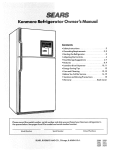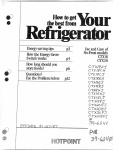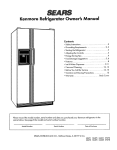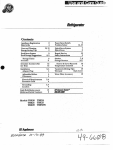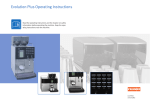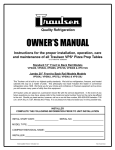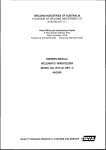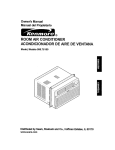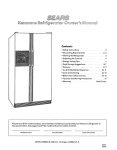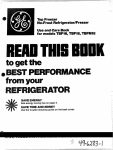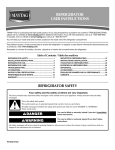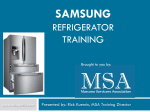Download GE TBX18 Refrigerator User Manual
Transcript
@ .--. , Contents Appliance Registration Base Grille Care andCleaning Condenser 12 12 Model and Serial Numbers 2 Problem Solver Repair Service Safety Instructions Energy Saver Switch Energy-SavingTips 5 2 Shelves Storage Drawers Food Storage Suggestions Storage Times 6 6 Drawer 8c Cover Removal Temperature Controls Ice Trays Icemaker .. 2 4 Icemaker Accessory Kit Installation Adapter Plug Adjustable Rollers Clearances Electrical Requirements Extension Cord Grounding Location Light Bulb Replacement Models TBX18 TBX20 GE Appliances 10 10 11 394 15 3 7 49 49 5 Vacation & Moving Tips 12 Warrantv Back Cover Water Filter Accessory 4 4 4 3.4 4 3 4 12 13,14 GEAnswer Center@ 800.b'2li2000 11 Energy-saving tips Help us help you. Read thisbook carefully. It is intended to helpyou operate and maintain your newrefrigerator properly. Keep it handy for answers to your questions. If you don’t understand something or need more help, write (include your phone number): Consumer Affairs GE Appliances Appliance Park Louisville, KY 40225 Write downthe model and serial numbers. You’ll see them on a label on the left side, near the top of the fresh food compartment. Before sending inthe registration card, please write these numbers here: Location of your refrigerator is important. Avoid locating it next to your range, a heating vent or where the sun will shine directly on it. Model Number Don’t open thedoors more often than necessary. Serial Number Use these numbers in any correspondence or service calls concerning your refrigerator. If you received a damaged refrigerator, immediately contact the dealer (or builder) that sold you the refrigerator. Save time and money. Before you requestservice, check the Problem Solver on pages 13 and 14. It lists causes of minor operating problems thatyou can correct yourself. These numbers are also on the Consumer Product Ownership Registration Card that came with your refrigerator. ,* Close the doors as soon as possible, particularly in hot, humid weather. Keep Energy Saver Switch in the left position unless moisture forms on the outsideof the refrigerator. Be sure the doors are closed tightly. Before leavingthe house or retiring for the night, check to be sure the doorshaven’t been left open accidentally. Store only those foods requiring refrigeration in your refrigerator. Wipe moisturefrom bottles and cartons before putting them in the refrigerator. Keep foods covered to reduce moisture buildup inside the refrigerator. If you turn the controls to the coldest position for quick chilling or freezing, be sure to turn them back to regular settings. Don’t overcrowd your refiigemtor. Overcrowding can require extra electrical energy to keep everything cool. h * & 2 ?. IMPORTANT SAFETY INSTRUCTIONS --. Read all instructions beforeusing this appliance. WARNING-When using this appliance, always exercise basic safety precautions, including the following: Use this appliance only for its intended purposeas described in this Use and Care Book. This refrigerator must be properly installedin accordance with the Installation Instructions before itis used. See grounding instructions below and on page4. Never unplug your refrigerator by pulling on the power cord. Always grip plug firmly and pull straight out from the outlet. Repair or replace immediately all electric service cords that have become frayed or otherwise damaged. Do not use a cord that shows cracks or abrasion damage along its lengthor at either the plug or connector end. Do not allow children toclimb, stand or hangon theshelves in the refrigerator.They could damage the refrigerator and seriously injure themselves. After your refrigeratoris in operation, donot touch thecold surfaces, particularlywhen hands are damp or wet. Skin may adhere to these extremely cold surfaces. If your refrigerator has an icemaker, do not place fingers or hands on the automaticicemaking mechanism while the refrigerator is plugged in. This will help protect also you from possible injury. It will prevent interference with the moving parts of the ejector mechanism, or with the heatingelement that releases the cubes. When movingyour refrigerator away from the w a ,lbecarefuinot to roll over or damage thepower cord. Don’t refreeze f m n foods which have thawed completely. The United States Departmentof Agriculture in Home and Garden Bulletin No. 69 says: “. ..You may safely refreeze frozen foods that have thawed if they still contain icecrystals or if theyare still cold-below 40°F. “. ..Thawed ground meats, poultry or fish that haveany off-odor or off-color should not be refrozen and should not beeaten. Thawed ice cream should bediscarded. If the odor or color of any foodis poor or questionable,get rid ofit. Thefood may be dangerousto eat. “Even partial thawing and refreezing reduce theeating quality of foods, particularly fruits, vegetables and prepared foods.The eating quality of red meatsis affected less than that of many other foods. Use refrozen foods as soon as possible to save as much of their eating quality as you can? If your old refrigerator is still around thehouse but not in use, be sure toremove the doors. This will reduce the possibility of danger tochildren. Unplug your refrigerator: A. Before making any repairs. Note: We strongly recommend that any servicing be performed by a qualified individual. B. Before cleaning. C. Before replacinga burned-out light bulb,the refrigerator should be unplugged in order to avoid contact witha live wire filament. (A burned-out light bulb may break when beingreplaced.) Note: Turningcontrol to OFF position does not remove power to the light circuit. Do not operate your refrigerator in the presence of explosive fumes. SAVE THESE INSTRUCTIONS Installation Requirements-IMPORTANT.. .Please Read Carefully. How to connect electricity 1 I PREFERRED METHOD For personal safety, this appliancemust be properly grounded. The power cordof this appliance is equipped witha three-prong (grounding)plug which mates with a standard three-prong (grounding) wall outlet (Fig. 1) to minimize the possibility of electric shock hazard from thisappliance. INSURE P R O ~ E R GROUND EXISTS BEFOREUSE Have walloutlet and circuit checked by a qualified electrician to make sure outlet is properly grounded. 3 Where a standardwall two-urong outlet is encountered, i’t is Gur personal responsibility and obligation to haveit replaced with a properly grounded three-prong wall outlet. DO NOT, UNDERANY CIRCUMSTANCES, CUT OR REMOVE THE THIRD (GROUND) PRONG FROM THE POWER CORD. (continued r u r page) hta11atiOn Requirements(continue+IMPORTANT.. Use of Adapter Plug ' Because of potential safety hazards under certain conditions,we strongly recommend against useof an adapter plug. However, if you still elect to use an adapter, where localcodespermit, a TEMPORARY CONNECI'ION may be made toa properly grounded two-prong wall outlet by use of a UL listed adapter (Fig. 2) available at most local hardware stores. I TEMPORARY METHOD I IAOAPTER PLUGS NOT PERMITTEO IN CANADA1 1:gK]1 a grounding type plug and outlet and that the electrical rating of the cord be 15 amperes (minimum) and 120 volts. The refrigerator should its own always be plugged into individual electrical outlet(115 volt, 60 Hertz, or 100 volt, 50 Hertz, single phase AC). This is recommended for best performance and to prevent overloading house wiring circuits, which could cause a fire hazard from overheating wires. .Please Read Carefully. Rollers/Leveling Legs Some models have adjustable rollers that enable you to movethe refrigerator away from thewall for cleaning; other models have adjustable leveling legs. Rollers or legs, located behind the base grille, should be setso the refrigerator is firmly positioned on the floor and the front is raised just enough thatthe doors close easily when opened about halfway. Refrigerator Location Do not install refrigerator where temperature will go below 60°F. I ?I I Larger slot in adapter must be aligned with larger slotin wall outlet to provide proper polarity in connection of power cord. CAUTION: Attaching adapter ground terminal towall outlet cover screw does not ground the appliance unless cover screw is metal, and not insulated, and wall outlet is grounded through house wiring. You should have the circuit checked by a qualified electricianto make sure the outlet is properly grounded. When disconnecting thepower always hold cord from the adapter, the adapter with one hand.If this is not done, the adapter ground terminal is very likely to break with repeated use. Should the adapter ground terminal break, DO N(YI' USE the appliance until a proper ground has again been established. Use of Extension Cords Because of potential safety hazards under certain conditions,we strongly recommend against the use of an extension cord. However, an extension if you still elect to use cord, it is absolutely necessary that it be a UL listed 3-wire grounding type appliance extension cord having because it will not run often enough to maintain proper temperatures. Do install it on a floor strong enough to support fully a loaded refrigerator. Also see Energy-Saving Tips regarding location. To adjust rollersor leveling legs, remove the basegrille by grasping it out. it at the bottom and pulling Clearances Allow the following clearances for ease of installation and properair circulation: Sides . . . . . . . . . 3/4" Top . . . . . . . . . . . . 1" Back . . . . . . . . . . . 1" Water Supply to Icemaker (on models so equipped) If your refrigerator has an icemaker, or if you plan to add an icemaker later, the icemaker will have to be connected to a cold water line. A water supply kit containing copper tubing, shut-off valve, fittingsand instructions is available at extra cost from your dealer. There should be sufficient tubing forthe icemaker from the cold water supply to allow moving the refrigerator out from the wall several feet (approximately8 feet of 1/4" copper tubing in three 10-inch diameter coils). 4 Turn roller adjusting screws or leveling legs clockwise to raise refrigerator, counterclockwise to lower it. Use adjustable wrench (3/8" hex head bolt)or pliers. When adjusting front rollersor leveling legs for proper door closure, it is recommended thatthe bottom front edgeof the cabinet be approximately 3/4" from the floor. To replace basegrille, align prongs on back of grille with clamps in cabinet and push forward until grille snaps into place. Operating Your Refrigerator p.. ~-.+sfj . Set the Temperature Controls TEMPERATURE CONTROLS E COLDEST COLDEST 9 ALLOW 24 HOURS FOR TEMPERATURES TO STABILIZE Your refrigerator hastwo controls that letyou regulate the temperature in the fresh food and freezer compartments. INITIALLY, set the FRESH FOOD control at5 and the FREEZER controlat C. For colder or warmer temperatures, adjust the desired compartment control one letter or number aat time. IMPORTANT When initially setting the controls or when adjusting them, allow24 hours for the temperatures to stabilize, or even out. Note: Turning the fresh food control to theOFF position stops cooling inBOTH compartmentsfresh food AND freezer-but does not shutoff power to the refrigerator. How to Test Temperatures Use themilk test for the fresh food compartment. Place a containerof milk on the top shelf in the fresh food compartment. Check it day a later. If the milkis too warmor too cold, adjust the temperature controls. If you turn your household thermostat below60°F. at night . . .you may want to turn the lettered control one step colder,as from “C” to “DI’Cooler temperatures in the house may cause the compressor to operate less frequently, thus allowing the freezer compartmentto warm somewhat. To protect your frozen food supply, leave yourlettered setting at this colder setting for the entire winter or for whatever period of time you are turning down your thermostat. This is especially important whenthe thermostat is turned down for an extended period. This change should have no effect on your fresh food compartment. However, if freezing occurs, turn the numbered control one step warmer, as from “5” to ‘‘4;’ When you stop turning the thermostat down, turn temperature controls backto their regular settings. Energy Saver Switch The Energy Saver Switch is located on the temperature control panel. Use the ice cream test for the freezer compartment.Place a To reduce the amount of container of ice cream inthe center electricity required to operate of the freezer compartment. Check your refrigerator, push switch to it after aday. If it’s toohard or too the left position. soft, adjust the temperature controls. This turnsoff heaters in your refrigerator that prevent moisture Always allow24 hours for from forming on the outside. the refrigerator to reach the temperature you set. 5 With the heaters turned off,there is a chance that moisture may form on the outside of your refrigerator, especially when the weatheris humid. The humidity is most likely to be high in the summer, in the early morning hours, and in homes which are not air conditioned. Over an extended period of time, moisture’that formson the outside may cause deteriorationof the paint to protect finish. It will be important the finishby using appliance polish wax as described on page 12. When the Energy Saver Switch is pushed to the right,electricity flows through the low wattage heaters which warm the outside of the cabinet and, under most conditions, prevent the forming of moisture or water droplets. No Defrosting It is not necessary to defrost the freezer or fresh food compartments. Your refrigerator is designed and equipped to defrost itself automatically. Food Storage Suggestions Suggested storage times for meat and poultry* IN Eatinp quality dmps after time shown IN REfRlGERAmR f REEZER 3!io AT to 40T. DAYS Fresh Meats Roasts (Beef & Lamb) . . . . . . . 3 to 5 Roasts (Pork & Veal) . . . . . . . . 3 to 5 Steaks (Beef) . . . . . . . . . . . . . . 3 to 5 Chops (Lamb) . . . . . . . . . . . . . 3 to 5 Chops (Pork) . . . . . . . . . . . . . . 3 10 5 Ground &Stew Meats . . . . . . . 1to 2 Variety Meats. . . . . . . . . . . . . . 1 to 2 Sausage (Pork) . . . . . . . . . . . . 1 to 2 AT 0% MONTHS 6 to 12 4 to 8 6 to 12 6to9 3 to 4 3 to 4 3to4 1 to2 Processed Meats Bacon . . . . . . . . . . . . . . . . . . . 7 Frankfurters. . . . . . . . . . . . . . . 7 Ham (Whole) . . . . . . . . . . . . . . 7 Ham (Half) . . . . . . . . . . . . . . . . 3 to 5 Ham (Slices) . . . . . . . . . . . . . . 3 Luncheon Meats . . . . . . . . . . . 3 to 5 Sausage (Smoked) ......... 7 Sausage (Dry & Semi-Dry) . . . . 14 to 21 1 ch 1 to2 1 to2 1 to2 Freezing not recommended. Cooked Meats Cooked Meats and Meat Dishes . . . . . . . . . . . . . 3 to 4 Gravy & Meat Broth . . . . . . . . . 1 to 2 2 to 3 2 to 3 Fresh Poultry Chicken &Turkey (Whole) . . . . 1 to 2 Chicken(Pieces) . . . . . . . . . . . 1 to 2 Turkey (Pieces). . . . . . . . . . . . . 1 to 2 Duck & Goose (Whole). . . . . . . 1 to 2 Giblets . . . . . . . . . . . . . . . . . . .1 to 2 12 9 6 6 3 Cooked Poultry Pieces (Covered with Broth). . . 1 to 2 Pieces (Not Covered) . . . . . . . . 3 to 4 Cooked Poultry Dishes. . . . . . . 3 to 4 Fried Chicken . . . . . . . . . . . . . . 3 to 4 (Other thanfor meats & poultry) 6 1 4 to 6 4 FREm Most fruits and vegetables . . . . . . . . . . ..8-12 months Lean fish ......................... .6-8months Fatty fish, rolls and breads, soups, stew, casseroles . . . . . . . . . . . ..2-3 months Cakes, pies, sandwiches, leftovers(cooked), Ice cream (original carton). . . . . . . . . . . 1 month m u . New techniques are constantly being developed. Consult the College or County Extension Service or your local Utility Company for the latest information on freezing and storing foods. 'U.S. Oepartment of Agriculture Meats, fish and poultry purchased from the store vary in quality and age; consequently, safe storage time in your refrigerator will vary. To store unfrozen meats, fish and poultry: Always remove store wrappings. Rewrap in foil, filmor wax paper and refrigerate immediately. To store cheese, wrap well with wax paper or aluminum foil, or put in a plastic bag. Carefully wrap to expelair and help prevent mold. Store pre-packaged cheese in its own wrapping if youwish. To store vegetables, usethe vegetable drawers-they've been designed to preservethe natural moisture and freshnessof produce. Covering vegetables with a moist towel helps maintaincrispness. As a further aid to freshness, pre-packaged vegetables can be stored in their original wrapping. Note: Specialf r e s h w compartment drawers (on modelsso equipped) make it unnecessary to wmp cemin foods which they've beendesigned to preserve. These drawers are described on pages 8 and 9. To store ice cream-Fine-quality ice cream, with high cream content, will normallyrequire slightly lower temperatures than more "airy" already-packaged brands with low cream content. It willbe necessary to experiment to determine the freezercompartment location and temperature control setting to keep your ice cream at the right serving temperature. The rear of the freezer compartment is slightly colder thanthe front. Tips on freezing foods There are threeessential requirements for efficient home freezing. 1. Initial quality. Freeze only topquality foods.Freezing retainsquality and flavor; it cannot improve quality. 2. Speed. The quickerfruits and vegetables are frozen after picking, the better the frozen product will be. You'll save time, too, with less culling and sorting to do. 3. Proper packaging. Use food wraps designed especiallyfor freezing; they're readily available at most food stores. 6 To freeze meat, fish and poultry, wrap well in freezer-weight foil (or other heavy-duty wrapping material) forming it carefully to the shape of the contents. This expels air. Fold and crimpends of the package to provide agood, lasting seal. Don't refreeze meatthat has completely thawed; meat, whether raw or cooked, canbe frozen successfully only once. Limit freezingof fresh (unfrozen) meats or seafoods to numberof pounds at a timeas follows: TBX18 . . . . . . . . . . . . . .17 pounds TBX20 . . . . . . . . . . . . ..19 pounds For convenience. .. Store like things together. This saves both time and electricity because you can find foods faster. Place the oldest items up front so they can be used up promptly. Use shelves on thedoor for most often used sauces and condiments. Use the meat drawer, on models so equipped, for temporary storage of meats youdo not freeze. To save money in energy and food costs Place mostperishable items, such as milk, creamor cottage cheese, toward the rear of the topshelf, as they will staycoldest in this part of the fresh food compartment. Cover moist foods with tight lids, plastic filmor foil. Leafvegetables and fruits placed in drawers will last longer when stored in closed plastic containersor wrapped in plasticfilm. Do not overload your fresh food or freezer compartment with a lot of warm foodat once. Open the door the fewest times possible to saveelectrical energy. When goingout of town for several days, leave as few perishables .%-?pssible in the refrigerator. If your refrigerator has an icemaker, move the icemakerfeeler arm to the OFF (up) position and shutoff water tothe refrigerator. Shelves How to rearrange your shelves (onmodels so equipped) Adjustable Shelves in Fresh Food Compartment Deep shelves on doorsof General Electric refrigerators provide convenient storage for frequentlyused items. (onmodels so equipped) Spacemaker Door Two-Position Shelf in Freezer Compartment (onmodels so equipped) Some models haveadjustable shelves in the fresh food compartment, enabling you rearrange the shelves to fit your family's food storage needs. Deeper shelves on Spacemaker Doors can accommodate two-liter a bottle on the bottom shelf and a six-pack on the shelf above it. To remove shelves:Tilt shelf up at front, then lift it up and out of tracks on rear wall of refrigerator. To remove shelf: Lift shelf off shelf supports, tilt it, and take it out. To relocate shelf: 1. After removing shelf. remove shelf supports by sliding them upward and replace them on other set of mounts. 2. Lower shelf onto relocated supports. Partial-Width Shelf in Freezer Compartment (onmodels so equipped] To replace shelves: Select desired shelf height. With shelf front raised slightly, engage top lugs in tracks at rear of cabinet. Thenlower front of shelf until it locks into position. Tempered glass shelves (on models so equipped) areadjustable in the same manner. Snuggeds), on models so equipped, aredesigned to give you storage flexibility on your fresh food door. Salad dressing, steak sauces and other condiments can now be kept securely against the door liner to help prevent tipping, spilling and sliding. For most efficient operation, place index finger and middle finger on either side of snugger and move it back andforth to fit your needs. 7 To relocate thisshelf against the opposite wall: 1. Remove shelf. 2. Remove shelf supports by sliding them upward and replace them on mounts on opposite wall. 3. Replace shelf with legless end on repositioned supports. General Electric Food-Saver System Adjusta-FreshDrawer 3 j L.’ (on models so equipped) This drawer has a second, inside cover. The adjustable humidity control lets you regulate the amount of coldair entering the drawer. Slide the control all the way to the rightto the “VEGETABLES” setting and the cover closesfully to provide a high humidity storage area. Cool’n Fresh Drawer Moist’n Fresh Drawer (on nlodels so equipped) (on mtdels so equipped) This refrigcrated 1/3-width drawer is designed t o provide temporary lower humidity storage for itenis such as: This refrigerated drawer is designed to keep unwrapped foods fresh by retaining the natural moisture content s as: of f i ~ dsuch Apples Apricots Grapes Mushrooms Nectarines Oranges Peaches Pears Raspberries Squash, summer Strawberries Tangerines Adjusta-Temp Drawer (on models so equipped) This V3-width drawer in some mtdels has an adjustable twoposition temperature control which let! you regulate the amount of cold air entering the drawer. When controlis all theway to the left at the “MEATS” setting,baffle is fully open to provide coldest storage area. When controlis all theway to the right at the‘‘FRUITS” setting, baffle is fully closed to provide normal refrigerator temperature. Artichokes Asparagus Beets, topped Blueberries Carrots Celery Cherries Plums Corn Radishes Currants Rhubarb Greens, leafy Spinach Lettuce Tomatoes, Parsley ripe Peas, green As in any refrigerated storage area, it is recommended that odorous foods be stored wrapped-foods such as: Broccoli Brussels Cabbage Cauliflower Green Onions Parsnips Turnips Storage time will depend upon the type of food andits condition when placed in the drawer. Excess water which may accumulate in the bottomof the Moist’n Fresh drawer should be poured out and the drawer wiped dry. The Moist’n Fresh drawer is partially sealed by gaskets attached to the cover at the front and back edges. Always replaceit in this cover and push the drawerall the wayin. Slide the control all the way to the left to the“FRUITS” setting and the cover stays partially open to provide a less humid storage area. Variable settings between“FRUITS” and “VEGETABLES” can be selected as user desires. Drawer Removal Drawers will stop before coming all the way out of the refrigerator to help prevent contents from spilling onto the floor. Drawers can be removed easily by tilting up slightly and pulling past “stop” location. To remove drawers when the fresh food compartment door cannot be opened fully, follow the procedure thatapplies to your model. c3 -I 1. Remove drawer farthest from door. If your refrigerator hastwin fruit and vegetable drawers: 2. Lift drawer cover up and p u @ d . it out. 1. Remove drawer door. farthest from Sealed Snack Pack (onmodels so equipped) a . ill, 2. Lift drawer cover up and pull it out. \ \ 3. Slide remaining drawer and cover to the middle. N\ V 4. Pull drawer out until it hits the stops. Then, with thumbs on edge of drawer cover trim, lift drawer slightly u p and out over the stops. 3. Slide remaining drawer and cover to the middle. place hand on cover and pull out drawer. The Sealed Snack Pack-and glass shelf to which is it attached-can be relocated within the fresh food compartment. The sealed drawer retains high humidity for convenient storage of meats and cheese, bacon, hors d’oeuvres, spreads and snacks. Detachable Meat Drawer or Meats’n Snacks Drawer (onmodels so equipped) The meat drawer canbe removed and taken to the sink or food preparation area. You may also relocate it within the fresh food compartment to suit your storage needs. To relocate meat drawer: If your meat drawer is attached to an adjustable shelf. drawer andshelf can be relocated at any level. 5. Place hand on drawer cover and pull out drawer. 4. Lift cover and remove it. After cleaning, replace in reverse order. If your refrigerator has steel wire shelves, meat drawer can also be , relocated on any shelf. Slide drawer out. remove drawercover from shelf above. relocate cover ondesired shelf. and slide drawer backin place. 6. Lift cover and remove it. After cleaning, replace in reverse order. Always replace theCool’n Fresh or Adjusta-Temp drawerin the left position. 9 Ice Service Ice Trays Automatic Icemaker / (on models so equipped) (on models so equipped) Your icemaker will produce eight cubes per cycle-approximately 100 cubes in a 24-hour period, depending on freezer compartment temperature, room temperature, number of door openings and other use conditions. Ice traysare designed to release ice cubes easily. Hold the tray upside-down overa container and twist both ends to release cubes. If your refrigeratoris operated before water connection is made to the icemaker, keep the icemaker feeler armin the OFF (up) position as shown below. Feeler Arm in OFF position / /F- Ice cube mold will automatically fill with water after cooling to freezing temperature, and first cubes will normally freeze after several hours. When cubesare solidly frozen, theywill be ejected from the mold into the ice storage bin by means of a sweeper arm. Icemaking will continueuntil the feeler arm sensesa sufficient accumulation of ice cubesin the storage bin and halts the operation temporarily. For maximum ice storage, level the stored cubeswith your hand occasionally. Be sure nothing interfereswith the swing of the feelerarm. The icemaker ejects cubesin groups of eight andit is normal for several cubes to be joined together. Once your icemaker is in operation, throwaway the first few batches of ice cubes. This will flush away any impurities in the water line. Do the same thing after vacations or extended periods when ice isn’t used. 0 For only one or two icecubes, leave the tray right-side up, twist both ends slightly and remove the number of cubes you want. Wash ice trays in lukewarm water only. Do not put them in an automatic dishwasher. Caution: ice Storage Bin When refrigerator has been connected to water supply, move ON (down) the feeler arm to the position. Feeler Arm in ON position Under certainrare circumstances, ice cubes may be discolored, usually appearing with a green-bluish hue.The cause of this unusual discoloration is apparently dueto a combination of factors suchas certain characteristics of local waters, household plumbing and the accumulation of copper salts in an inactive water supply line which feedsthe icemaker. Continued consumptionof such discolored ice cubes may be injurious to health.If such discoloration is observed, discard the ice cubes and contact yourGE Factory Service Center or an authorized Customer Care@ servicer. ’ 10 Move icemaker feeler arm to OFF (up) position when: home water supply is to be off for several hours ice storage binis to be removed for a period of time going away on vacation, at which time you should also turn off the valve in the water supply line to your refrigerator If ice is used infrequently, old cubes will become cloudy and taste stale. Empty ice storagebin periodically andwash it in lukewarm water. Automatic Icemaker Accessory Kit Water Filter Accessory (optional atextra cost) (optional atextra cost) An automatic icemaker will replace the ice you use.. . automatically. It can keepyou supplied with a binful of cubes-ice for everything, everybody-without fuss or muss. If your refrigerator did not come already equipped with an automatic icemaker, you may add onecontact your local GE dealer; specify UK-KIT-2 or UK-KIT4 A water supply kit containing copper tubing, shut-off valve, fittings and instructions needed to connect the icemaker to your cold water line isalso available at extra cost. Your ice cubes can only be as fresh-tasting as the water that produces them. That’s why it’s a good ideato purify your water witha water filter. Its activated charcoal removes musty, stale odors and unpleasant medicinal, metallic tastes. A porous fiber cartridge catchesdirt, rust particles, sand and silt while special crystals reduce depositsof hard scale. The water filter is available from your GE dealer. SpecifyWR97X214. It has complete installation instructions and installsin minutes on 1/4” OD copper water line. If this is yourfirst icemaker, you’ll hear occasional sounds that may be unfamiliar. They are normal icemaking sounds and arenot cause for concern. m:, l L .:,; bd> 11 Care and Cleaning Cleaning-Outside The door handles and trim can be cleaned with a cloth dampened with a solutionof mild liquid dishwashing detergent and water. Dry withsoft a cloth. Don't wax handlesor trim. * Keep the finish clean. Wipe with a clean cloth, lightly dampened with kitchen appliancewax or mild liquid dishwashing detergent. Dry and polish with aclean, soft cloth. Do not wipe the refrigerator with a soiled dishwashing clothor wet towel. These may leave a residue that can damagethe paint. Do not use scouring pads, powdered cleaners, bleach, or cleaners containing bleach, because these products can scratch and weaken the paint finish. Protect the paint finish. The finish on the outside of the refrigerator is a high quality, baked-on paint finish. With proper care, it will stay newlooking and rust-free for years. Apply acoat of kitchenlappliance wax when the refrigerator isnew, and then at least twice a year. Appliance PolishWax 8c Cleaner (Cat. No. WRWX216) is available from GE Appliance PartsMarts. . To help prevent odors, leave an open box of baking soda the in rear of the refrigerator, onthe top shelf. Change the box everythree months. An open box of baking soda in the freezer willabsorb stale freezer odors. Do not wash any of your refrigerator's plastic parts in your automatic dishwasher. Behind refrigerator Care should be taken in moving your refrigeratoraway from the wall. All typesof floor coverings can be damaged,particularly cushioned coverings andthose with embossedsurfaces. If your refrigerator is on wheels, pull it straight out and returnit to position by pushing itstraight in. Moving your refrigerator in side a direction may result in damage to yourfloor covering or refrigerator. Condenser On other models, a bulb and socket are located behind a shield directly below the temperature control panel. To replace a lightbulb, unplug the refrigerator's power cord and plug from the walloutlet. Then reach up behind the shield, unscrew the burned out bulb, andreplace it with a standard 40-wattappliance bulb. When yougo on vacation For extendedvacations or absences, remove food and shut off power to the refrigerator. Cleanthe interior with bakingsoda solution of one tablespoonof soda to one quart of water. Wipe dry. To prevent odors, leave openbox of baking soda in refrigerator. Leavedoors open. For shorter vacations, remove perishable foods and leave controls at regular settings. However, if room temperature is expected to drop below 60"F., follow same instructions as for extended vacations. For most efficientoperation, you If your refrigeratorhas an need to keepthe condenser clean. icemaker, move the icemaker Turn temperature controlto OFF. feeler arm tothe OFF (up) position Remove the basegrille, if your and be sure to shut offthe water Cleaning-Inside refrigerator has one-see page 4. supply to the refrigerator. Clean the inside of the fresh food Sweep away or vacuum dust thatis readily accessible and freezer compartmentsat least on condenser When you move once a year. Unplug refrigerator coils, then turn before cleaning. this If is not practical, Disconnect the power cord from the control back wring excess moisture out of sponge on. This easy the wall outlet, remove all food, or cloth when cleaning around cleaning operation and clean anddry the interior. switches, lightsor controls. should be done at Secure loose all items such as Use warm water and baking soda least once a year. shelves and storagepans by taping solution-about a tablespoon of them securely inplace to prevent baking soda to aquart of water. damage. Light bulb replacement This both cleans and neutralizes Be sure the refrigerator stays in odors. Rinse thoroughly with an upright position during actual water and wipe dry. moving and inthe van. TheOther parts of the refrigeratorrefrigerator must besecured in the including door gaskets, meat and van to prevent movement. Protect On some models, a light bulb and vegetable drawers, ice storage the outside of the refrigerator with socket are located behind ashield container and all plastic parts-can a blanket. on eachside of the temperature be cleanedthe same way. Do not control panel. - *e?* use cleansing powdersor other abrasive cleaners. gj) c Rapid Electrical Diagnosis = :mQuestions? Use This Problem Solver ' -r - -?Ez€ZF Your refrigeratoris wired for accurate electrical diagnosis home-takes in your only minutes forservice a technician to check itsentire electrical system. No need for the technician to move the refrigeratorto make the diagnosis. PROBLEM POSSIBLE CAUSE AND REMEDY REFRIGERATOR DOES NOT OPERATE May be in defrost cycle when motordoes not operate for about 35 minutes. Temperature control in OFF position. If interior light is not on, refrigerator may not be plugged in at wall outlet. If plug is secure and the refrigerator still fails to operate, plug a lampor a small appliance intothe same outlet todetermine if there is a tripped circuit breaker or burned outfuse. MOTOR OPERATES FOR LONG PERIODS Modern refrigerators with more storagespace and alarger freezer compartment require moreoperating time. Normal whenrefrigerator is first delivered to your home-usually requires 24 hours to completelycool down. Large amountsof food placed inrefrigerator to becooled or frozen. Hot weather-frequent door openings. Door left open. Temperature controls are set toocold. Refer to page5. Grille and condenser need cleaning. Refer to page 12. Check ENERGY-SAVING TIPS on page2. MOTOR STARTS & STOPS FREQUENTLY Temperature control starts and stops motorto maintain eventemperatures. VIBRATION OR RATTLING If refrigerator vibrates, more than likely it is not resting solidly on the floor. The front roller screwsor front leveling legs need adjusting, or floor is weak or uneven. Refer to ROLLERYLEVELING LEGS on page 4. If dishes vibrate on shelves, try moving them. Slight vibration is normal. OPERATING SOUNDS The high speed compressor motor required to maintain near zero temperatures in the large freezer compartment may produce higher sound levels than your old refrigerator. Normal fan air flow-one fan blows cold air through the refrigerator and freezer compartments-another fan cools the compressor motor. These NORMALsounds will also be heard fromtime to time: Defrost timer switch clicks at defrost. Defrost waterdripping. Temperature control clicks ON or OFF. Refrigerant boilingor gurgling. Cracking or popping of cooling coils caused by expansion and contraction during defrost andrefrigeration following defrost. Ice cubes dropping into the bin and water running in pipes as icemaker refills. FOODS DRYOUT Foods not covered, wrapped or sealed properly. (conrinued nexr page) 13 The Problem Solver (continued) 0- r I 1 PROBLEM ~- POSSIBLE CAUSE AND REMEDY Normal air flow cooling motor. In the refrigeration process, it is normal that heat be expelled in the area under the refrigerator. Some floor coverings will discolor at these normal and safe operating temperatures. Your floor covering supplier should be consulted if you object tothis discoloration. HOT AIR FROM B(TTTOM OF REFRIGERATOR ' ~~ FRESH FOOD OR FREEZER COMPARTMENT TEMPERATURE TOO WARM Temperature control not set cold enough. Refer to page 5. Warm weather-frequent door openings. Door left open for too long a time. Package holdingdoor open or blocking air duct in freezer compartment. Package blockingair duct in freezer compartment. FROST OR ICE CRYSTALS ON FROZEN FOOD Door may have beenleft ajar or package holdingdoor open. Too frequent or too longdoor openings. Frost within packageis normal. Icemaker feelerarm in OFF (up) position. Water supply turned off or not connected. Freezer compartmenttoo warm. Cubes too small-water shutoff valve connecting refrigerator to home water line may be clogged. AUTOMATIC ICEMAKER DOES NOT WORK (on modelsso equipped) Door may have beenleft ajar. Turn temperatureof freezer compartment colder. SLOW ICE CUBE FREEZING - ~~ Old cubes need to be discarded. Ice storage container needs to be emptied and washed. Unsealed packages in refrigerator and/or freezer compartmentsmay be transmitting odor/taste to ice cubes. Interior of refrigerator needs cleaning. Refer to page 12. ICE CUBESHAVE ODOR/TASTE ~ MOISTURE FORMS ON OUTSIDEOF REFRIGERATOR r ~~~~ Not unusual during periods of high humidity. Move Energy Saver Switch to right. the I\ x 1 ~~ MOISTURE INSIDE. REFRIGERATOR HAS ODOR Too frequent or too longdoor openings. In humid weather,air carries moisture into refrigerator when doors are opened. Foods with strong odors should be tightly covered. Check for spoiled food. Interior needs cleaning. Referto page 12. Defrost water system needs cleaning. Keep openbox of baking soda in refrigerator; replace every three months. If you need morehelp.. .call, toll free: GE Answer Center@ 800.6262000 consumer information service 14 If You Need Service . I. ' . ,*-- --- To obtain service, see yourwarranty on the back page of this book. We're proud of our service and want you to bepleased. If for some reason you are not happy withthe service you receive, hereare three steps to follow forfurther help. FIRST, contact the people who serviced your appliance. Explain why you are not pleased. In most cases, this will solve the problem. NEXT, if you are still not pleased, write all the details-including your phone number-to: Manager, Consumer Relations GE Appliances Appliance Park Louisville, Kentucky40225 FINALLY, if your problem is still not resolved, write: Major Appliance Consumer Action Panel 20 North Wacker Drive Chicago, Illinois60606 15 . .. YOUR GENERAL ELECTRIC REFRIGERATOR WARRANTY WHAT IS COVERED FULL ONE-YEAR WARRANTY For one year from date oforiginal purchase, we will provide, freeof charge, parts and service labor in your home to repair or replace any part of the refrigerator that fails because of a manufacturing defect. FULL FIVE-YEAR WARRANTY For five years from date oforiginal purchase, we will provide, freeof charge, parts and service laborin your home to repair or replace any part of the sealed refrigerating system (the compressor, condenser, evaporator andall connecting tubing) that fails because of a manufacturing defect. WHAT 1s NOT COVERED Service trips to your home to teach you howto use the product. Read your Use and Care material. If you then have any questions about operating the product, please contact your dealeror our Consumer Affairs office at the address below, orcall, toll free: GE AnswerCenteP 800.626.2000 consumer information service This warranty is extended to the original purchaser and any succeeding owner forproducts purchased for ordinary home use in the 48 mainland states, Hawaii and Washington, D.C. In Alaska the warranty is the same exceptthat it is LIMITED because you mustpay to ship the product to the service shop or forthe service technician's travel costs to your home. All warranty servicewill be provided by our Factory ServiceCenters or by our authorized Customer Care@ servicers during normal working hours. Look in the White or Yellow Pages of your telephone directory for GENERAL ELECTRIC COMPANY, GENERAL ELECTRIC FACTORY SERVICE, GENERAL ELECTRICHOTPOINT FACTORY SERVICE or GENERAL ELECTRIC CUSTOMER CARE@ SERVICE. Replacement of house fuses or resetting of circuit breakers. Failure of the product if it is used for other than its intended purpose or used commercially. Damage to productcaused by accident, fire, floods or acts of God. WARRANTOR IS NOTRESPONSIBLE FOR CONSEQUENTIAL DAMAGES. Improper installation. If you havean installation problem, contact your dealeror installer. You are responsible for providing adequate electrical, plumbing and other connecting facilities. Some statesdo not allowthe exclusion or limitation Of incidental or consequential damages, SO the above limitation or excluSion may notapply to you. This warranty gives youspecific legal rights, and you may also have other rights which vary from state to state. To know what yourlegal rights are in your state,COnSUlt your local or State consumeraffairs office or your state'sAttorney General. Warrantor: General Electric Company If further help is needed concerning this warranty, write: Manager-Consumer Affairs, General Electric Company, AppliancePark, Louisville, KY40225 Part No. 468344P03 Pub. NO.49-6512 TBX18 TBX20
















